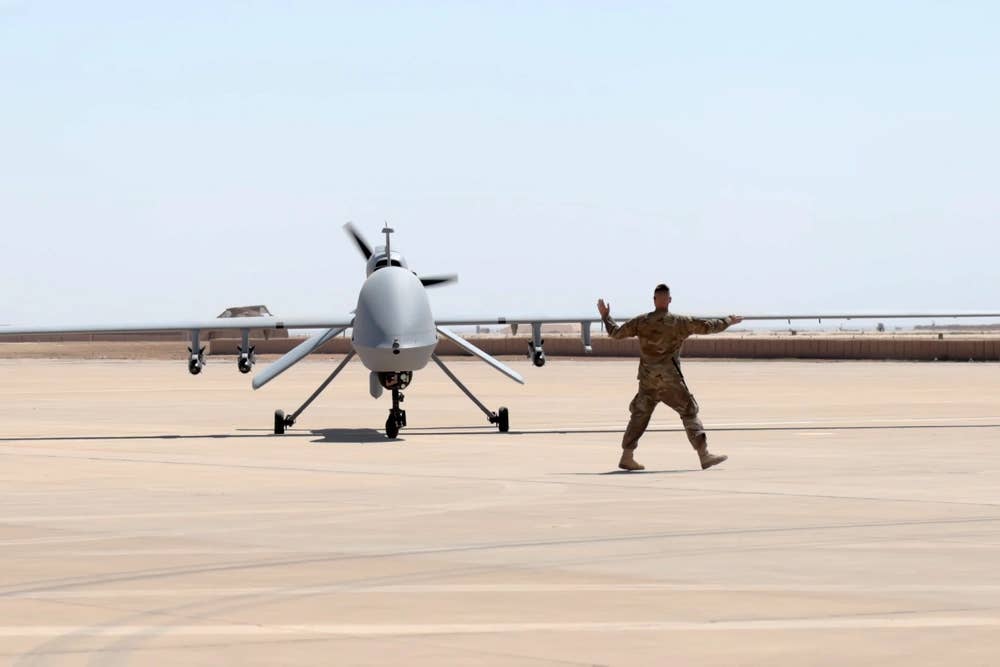
A U.S. Army soldier ground guides a MQ-1C Gray Eagle unmanned aircraft system. [U.S. Army photo by Spc. Devin Fleming.]
A White House plan to sell Ukraine four General Atomics MQ-1C Gray Eagle armed combat drones was halted following concerns by Pentagon officials, according to Reuters.
Earlier this month, the White House announced it was sending Ukraine additional military aid in the form of a drawdown of equipment from U.S. defense inventories, as well as $1 billion in security assistance in the form of artillery and coastal defense weapons. News of the aid in recent weeks came as the Biden Administration was reportedly shoring up plans to also sell four MQ-1C Gray Eagle combat drones to Ukraine. The Gray Eagle is capable of carrying up to four Hellfire missiles, and could provide armed intelligence, surveillance and reconnaissance (ISR) capabilities with added features of automatic takeoff and landing.
It is the sensitive, high-value radar and surveillance equipment on the drones, however, that pose a potential security risk for the U.S. should one end up in Russian possession, according to objections that emerged during a review by the Pentagon Defense Technology Security Administration, Reuters reported.
"Technology security reviews are a standard practice for the transfer of U.S. defense articles to all international partners," Pentagon spokesperson Sue Gough told the news agency. "All cases are reviewed individually on their own merit. Through the established process, national security concerns are elevated to the appropriate approving authority."
The Gray Eagle sale proposal is now being "reviewed higher up the chain of command at the Pentagon," Reuters said.
Should the sale eventually get the green light at the Pentagon, however, the proposal faces other potential challenges before the Ukrainian military would be able to deploy the capability. The sale would have to pass muster with Congress.
Then there's the operational challenges on the ground. Operators of the more complex armed drones traditionally need months of training, and infrastructure, such as runways, are needed for its takeoff and landing, Politico reported.
Game Changer
Observers have long said the addition of the armed combat drone would be a much needed boost to Ukraine's air defense strategy.
Despite the successes of combat drones in Ukraine, “they still need more,” from fighter jets to UAVs packing a bigger punch, Doug Birkey, executive director of the Mitchell Institute for Aerospace Studies, told FLYING in late March.“The effect they could yield is pretty substantial,” Birkey said. “It would be a big force multiplier.”
While the MQ-1C sale has stalled, the U.S. has provided an arsenal of smaller combat drones to Ukraine as part of military aid in its fight against Russia.
The U.S. has sent Puma unmanned aerial systems, as well as hundreds of Switchblade "kamikaze" UAVs. The latter are short-range piloted missiles that are launched from a tube, like a mortar, and come in two sizes. The Switchblade 300 is nearly 6 pounds, while the Switchblade 600 weighs in around 120 pounds. They’re considered “loitering munitions,” and they can change course mid-flight.
Ukraine has also received more than 121 Phoenix Ghost tactical drones that were rapidly developed by the U.S. Air Force for the fight. The AEVEX Aerospace manufactured drones were already in development prior to the war in Ukraine. While little is known about the ghost drones, they are similar to the “Switchblade” combat drones included in previous aid packages.
“This unmanned aero system is designed for tactical aerial operations,” Pentagon spokesperson John Kirby said at the time of their announcement. Its purpose is akin to the Switchblade combat drone, which is a one-way attack drone. The system, which is equipped with optics, can also be used to provide a sight picture. “But its principal focus is to attack,” Kirby said.
The Turkish-made Bayraktar TB2 drone has also been celebrated as a force multiplier, a symbol of Ukraine’s resistance to the Russian invasion, as well as a source of national pride.

Sign-up for newsletters & special offers!
Get the latest FLYING stories & special offers delivered directly to your inbox






